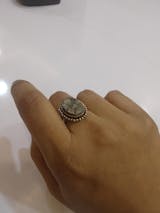Sapphires, the birthstone of September, are renowned for their captivating deep blue color, symbolizing purity, wisdom, and protection. Revered across ancient cultures and modern royalty, Sapphires have a rich history as symbols of nobility and guardians against harm. Lapis Lazuli, another important Gemstone for September born, represents truth, clarity, and spiritual insight. Both gemstones offer timeless beauty and powerful symbolism, making them treasured choices for personal adornment and spiritual connection. Proper care ensures their lasting brilliance and significance.
Sapphire
Sapphires, the birthstone of September, are among the most coveted gemstones in the world, renowned for their exquisite deep blue hue that has captivated civilizations throughout history. These gemstones embody a legacy of beauty, nobility, and mystery, making them a symbol of the heavens, a guardian of innocence, and a promoter of good health.
History of Sapphires
The history of Sapphires is as rich and colorful as the gemstone itself. Historically, the ancient Persians believed the earth was supported by a giant Sapphire, and its reflection colored the sky. In medieval times, Sapphires were worn by royalty and the clergy as symbols of nobility and truth. They were also believed to protect the wearer from envy and harm. Famous Sapphires throughout history include the Star of India, one of the world's largest and most renowned star sapphires, and the Logan Sapphire, one of the largest faceted gem-quality blue Sapphires. The British Crown Jewels also feature Sapphires prominently, symbolizing wisdom and purity.In more recent history, Sapphires have become synonymous with royal engagements.
Where is Sapphire Found?
Sapphires are found in various regions around the world, each known for producing different types and colors. The Kashmir region, between India and Pakistan, is famous for its rare "cornflower" blue sapphires, which were mined in the late 19th and early 20th centuries. Myanmar (Burma) is renowned for its deep blue sapphires, while Sri Lanka produces a wide range of colors, including the coveted Padparadscha sapphires with pink-orange hues. Thailand and Madagascar are also significant sources, offering sapphires in various shades, including yellow, pink, and purple. Australia's sapphires, particularly from Queensland, are known for their darker tones. These regions contribute to the gemstone's global appeal and variety, making sapphires highly sought after.
Symbolism Of Sapphire
Sapphires have been cherished as powerful talismans and symbols of the divine for thousands of years. As the birthstone for September, Sapphires are thought to protect their wearers, guarding against evil and poisoning when worn close to the skin. Moreover, Sapphire's deep blue is often associated with purity, wisdom, dignity, and loyalty, making it an ideal gift to symbolize a deep and lasting connection.
The significance of Sapphires in various cultures is profound. In Buddhism, the Sapphire is associated with devotion and enlightenment, while in Christianity, it represents purity and wisdom. Its universal appeal lies in its striking beauty and the belief in its power to protect and enlighten.
Properties
Sapphires are admired for their beauty and durability, but they also carry various symbolic and healing properties. Known for their protective and calming effects, sapphires are prized for both jewelry and spiritual uses.
- Emotional Balance: Sapphires help calm the mind, reduce stress, and bring emotional clarity, promoting peace and serenity in difficult situations.
- Protection: Often considered a protective stone, sapphires are believed to shield the wearer from negative energies and harm, enhancing safety and security.
- Wisdom and Insight: Sapphires are said to stimulate wisdom and understanding, improving decision-making and encouraging thoughtful reflection.
- Physical Healing: Sapphires are thought to aid in physical healing, especially for the eyes and throat, supporting overall well-being.
- Spiritual Growth: This gemstone is believed to enhance spiritual growth, connecting the wearer to higher energies and fostering enlightenment.
Caring for Sapphire
- Sapphires can be cleaned with warm, soapy water and a soft brush. Avoid harsh chemicals or abrasive materials that could scratch the metal setting or the gemstone.
- Store your Sapphire jewelry separately from other pieces to prevent scratches. A fabric-lined jewelry box with dividers or individual soft pouches is ideal.
- Despite their durability, Sapphires can be damaged by a hard blow. Remove your Sapphire jewelry during activities that could expose it to harsh chemicals or physical impact.
- Sudden temperature changes can cause damage to Sapphires, especially those that have been treated or have inclusions. Avoid exposing your Sapphire jewelry to extreme heat or cold.
Other Crystal For September: Lapis Lazuli
Lapis Lazuli, the birthstone for September, is treasured for its deep, celestial blue color and golden flecks of pyrite, symbolizing wisdom, truth, and royalty. Its rich history dates back thousands of years, with ancient civilizations, including Egypt and Mesopotamia, venerating the stone for its beauty and spiritual significance. Lapis Lazuli was used in jewelry, amulets, and even ground into powder for sacred ceremonies. It was also believed to offer protection and inner peace to its wearers, making it highly prized across various cultures. This gemstone promotes clarity, honesty, and enlightenment, helping those who wear it connect with their inner truth. Lapis Lazuli's enduring beauty and powerful symbolism make it a timeless choice in jewelry and spiritual practices.
Where is Lapis Lazuli Found?
Lapis Lazuli is primarily found in Afghanistan, particularly in the Badakhshan region, where it has been mined for over 6,000 years. This area produces some of the finest-quality stones with intense blue hues. Other notable sources include Chile, where Lapis Lazuli is found in lighter shades of blue, and Russia, where it is often used for ornamental purposes. Smaller deposits can also be found in the United States, Italy, and Pakistan. The stone's vibrant color and long history of use in art and jewelry have made it highly sought after across the globe. Afghanistan remains the most significant source, providing top-grade Lapis Lazuli for centuries.
Symbolism of Lapis Lazuli
Lapis Lazuli has been revered as a symbol of wisdom, truth, and spiritual insight for thousands of years. Ancient Egyptians used it to honor the gods and promote enlightenment, while Buddhists believe it fosters inner peace. It is also associated with royalty and protection, often worn by kings and queens to inspire strength and clarity. Its deep blue color represents the heavens, offering wearers a sense of calm and mental clarity. Whether for spiritual or aesthetic purposes, Lapis Lazuli holds a special place in human history for its powerful symbolic meanings.
Properties of Lapis Lazuli
- Emotional Clarity: Lapis Lazuli helps clear confusion and promotes honest communication, fostering emotional balance and inner peace.
- Protection: This stone is believed to offer protection from negative energies, guarding against harm while promoting mental and spiritual well-being.
- Wisdom and Insight: Lapis Lazuli is associated with enhancing wisdom and truth, helping to improve decision-making and self-awareness.
- Physical Healing: It is said to support healing for the throat, respiratory system, and immune function, promoting overall health and vitality.
- Spiritual Growth: Lapis Lazuli aids spiritual growth by deepening meditation practices and connecting individuals to their higher consciousness.
Discover the timeless beauty and wisdom of Lapis Lazuli. Known for enhancing clarity, truth, and spiritual growth, this gemstone is perfect for those seeking deeper self-awareness. Explore our Lapis Lazuli collection here and elevate your journey.
Caring for Lapis Lazuli
- To maintain its beauty, clean Lapis Lazuli with a soft cloth and mild soap, avoiding chemicals and abrasives that could damage the stone.
- Store it separately from harder gemstones to prevent scratches, ideally in a soft pouch or fabric-lined jewelry box.
- Remove Lapis Lazuli jewelry during activities that may expose it to harsh chemicals, like swimming or cleaning.
- Avoid extreme temperatures, as the stone can crack or become damaged. Regular care ensures that Lapis Lazuli will remain vibrant and beautiful for years to come.
Sapphires and Lapis Lazuli, both birthstones of September, are treasured for their deep blue hues and rich histories. Sapphires symbolize purity, wisdom, and protection, while Lapis Lazuli represents truth, clarity, and spiritual insight. Both gemstones have been revered across cultures, from ancient civilizations to modern royalty. Sapphires are found in regions like Kashmir, Myanmar, and Sri Lanka, and are known for their durability and calming properties. Lapis Lazuli, primarily sourced from Afghanistan, has been used for centuries in jewelry and spiritual practices. Proper care, including gentle cleaning and avoiding extreme temperatures, ensures that these gemstones maintain their beauty and significance. Whether for jewelry or spiritual purposes, both stones offer timeless beauty and powerful symbolism.













